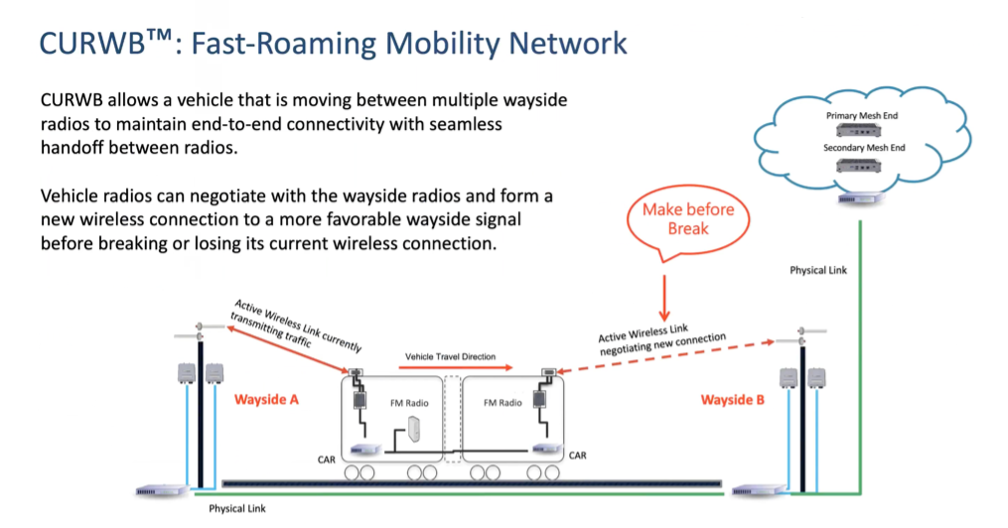The biggest challenge for most metro travellers is that they do not get the ‘always on’ seamlessly connectivity on board. The current experience is one with buffering, lags, and interruptions as they try to stream movies, scroll social media feeds, or join a video conference call on the go. Today’s generation is constantly glued to their screens for work and leisure; as a result, anyone can imagine how frustrating the lack of connectivity might be to them.
One of our customers in Asia learned about Cisco’s Ultra-Reliable Wireless Backhaul (CURWB) technology which is being deployed by some of the world’s smart transportation, airports, seaports, and IoT-powered mega-campuses. Impressed by the ability of the technology to deliver a higher bandwidth to objects & vehicles traveling at high speeds, at low latencies, they decided that CURWB was the technology to support their next-gen metro coaches.
High-speed Wi-Fi on your metro
In just a couple of months, the team went from discussion to drawing board to deployment, and now, passengers can enjoy ‘high-speed Wi-Fi while aboard the train’ just as they do at any other café, exhibition hall, or even in their office. Of course, customers are happy. They’re using it to access applications which they otherwise wouldn’t be able to use – not without hinderances at least.
On the surface, the technology may not sound ground-breaking, but it is. Here’s why: The train typically moves at a speed of 80 to 100 kmph. To connect to the internet, the metro cars are equipped with radios that connect with access points installed on poles along the tracks.
In the typical scenario, without CURWB, the radio in the metro coaches would need to connect to one access point after another for a seamless connection. However, given the speed at which the train is moving, you can imagine how tough it would be to establish that connection in the short span of time between access points.
With CURWB, however, this is exactly where the magic happens. The technology follows a proprietary ‘make before break’ logic which allows it to hold on to an active wireless link currently transmitting traffic while simultaneously negotiating a new link connection.

CURWB, as a result, is able to deliver a zero millisecond, lossless handoff between access points. Connection speeds go up to 500 Mbps per metro car, with high availability and low latency, enabling more than just work or play for customers. This could potentially pave the way for the deployment of futuristic technology applications such as augmented reality (AR) and virtual reality (VR) offerings, autonomous solutions, and more.
Well, CURWB looks like the perfect solution – but is there anything else that could do an equally good job? Not really.
From afar, 5G looks like a great contender but it may face challenges in maintaining consistent connectivity in high-speed train environments due to factors such as signal blockage and handover complexities. Further, the requirement of dedicated 5G spectrum and device eco-system availability make it hard for 5G to deliver this capability inside a metro, in the near term. CURWB’s ability to leverage advanced techniques such as redundancy, dynamic beamforming, and adaptive transmission power to ensure reliable communication make it the best option in high-speed metro environments.
Wi-Fi 6 is another top contender but like 5G, in the environment the project was deployed, reliability and coverage would be big hurdles to delivering the connectivity that is needed for the operator’s customers. The table below shows how CURWB compares with some of the other networking technologies in today’s market:

The win-win value proposition
Our customer currently has dozens of stations on their metro line serving hundreds of thousands of passengers every year. If you’re wondering, the customer deployed an access point every 250 meters along the metro tracks for this project. Further, they define the bandwidth per user to ensure that the 500 Mbps is divided equally among passengers with plenty to spare for operational use.
The investment in connectivity immediately helped the metro operator to gain a competitive advantage in the eyes of customers who would otherwise travel by car so they could stay connected to work or watch something entertaining. If you think about it, this is a big win, not only for the company but also for the nation’s economy and its environment. However, that’s not where it ended.
The leaders running the metro operations decided to work with a partner to provide the improved Wi-Fi connectivity to customers with value added services such as entertainment & edutainment content, relevant advertisements, and more. Their customers are truly delighted as a result.
In summary, this transformative leap in metro connectivity has been a game-changer, not only in enhancing passenger experience, but also in unlocking new revenue streams and opportunities for partnerships.
By investing in Cisco’s Ultra-Reliable Wireless Backhaul technology, the metro operator has not only addressed the critical issue of network connectivity on the move, but also set the foundation for more innovative applications in the future. It’s an example of how, in today’s world, being truly connected goes beyond mere access to the internet – it’s about seamless, uninterrupted digital experiences that add value to our lives, wherever we are.
This visionary approach to connectivity has truly redefined the journey for metro commuters, and it’s only a glimpse of the exciting possibilities it can create for the operator in the smart transportation era.
Excited about getting to experience it live in my homecity in India, Asia. Waiting to know which country got the chance at first?